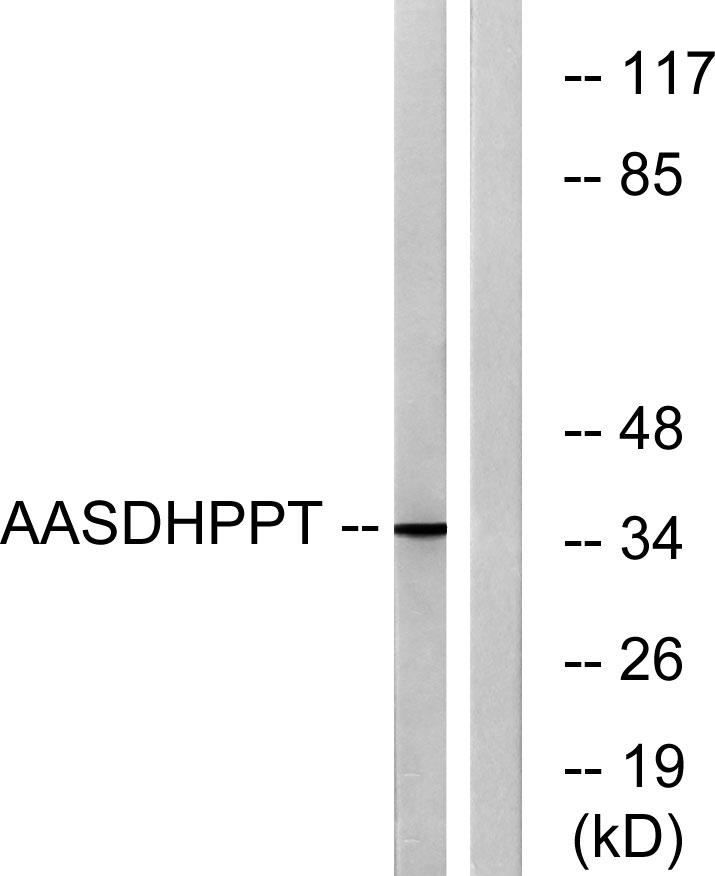AASD-PPT Polyclonal Antibody
- Catalog No.:YT0040
- Applications:WB;IHC;IF;ELISA
- Reactivity:Human;Mouse;Rat
- Target:
- AASD-PPT
- Fields:
- >>Pantothenate and CoA biosynthesis;>>Metabolic pathways
- Gene Name:
- AASDHPPT
- Protein Name:
- L-aminoadipate-semialdehyde dehydrogenase-phosphopantetheinyl transferase
- Human Gene Id:
- 60496
- Human Swiss Prot No:
- Q9NRN7
- Mouse Gene Id:
- 67618
- Mouse Swiss Prot No:
- Q9CQF6
- Rat Gene Id:
- 300328
- Rat Swiss Prot No:
- B2RYJ4
- Immunogen:
- The antiserum was produced against synthesized peptide derived from human AASDHPPT. AA range:11-60
- Specificity:
- AASD-PPT Polyclonal Antibody detects endogenous levels of AASD-PPT protein.
- Formulation:
- Liquid in PBS containing 50% glycerol, 0.5% BSA and 0.02% sodium azide.
- Source:
- Polyclonal, Rabbit,IgG
- Dilution:
- WB 1:500 - 1:2000. IHC 1:100 - 1:300. ELISA: 1:40000.. IF 1:50-200
- Purification:
- The antibody was affinity-purified from rabbit antiserum by affinity-chromatography using epitope-specific immunogen.
- Concentration:
- 1 mg/ml
- Storage Stability:
- -15°C to -25°C/1 year(Do not lower than -25°C)
- Other Name:
- AASDHPPT;CGI-80;HAH-P;HSPC223;x0005;L-aminoadipate-semialdehyde dehydrogenase-phosphopantetheinyl transferase;4'-phosphopantetheinyl transferase;Alpha-aminoadipic semialdehyde dehydrogenase-phosphopantetheinyl transferase;AASD-PPT;
- Observed Band(KD):
- 36kD
- Background:
- The protein encoded by this gene is similar to Saccharomyces cerevisiae LYS5, which is required for the activation of the alpha-aminoadipate dehydrogenase in the biosynthetic pathway of lysine. Yeast alpha-aminoadipate dehydrogenase converts alpha-biosynthetic-aminoadipate semialdehyde to alpha-aminoadipate. It has been suggested that defects in the human gene result in pipecolic acidemia. [provided by RefSeq, Jul 2008],
- Function:
- catalytic activity:CoA-[4'-phosphopantetheine] + apo-[acyl-carrier-protein] = adenosine 3',5'-bisphosphate + holo-[acyl-carrier-protein].,cofactor:Binds 1 magnesium ion.,function:Catalyzes the post-translational modification of target proteins by phosphopantetheine. Can transfer the 4'-phosphopantetheine moiety from coenzyme A to a serine residue of a broad range of acceptors, such as the acyl carrier domain of FASN.,PTM:Phosphorylated upon DNA damage, probably by ATM or ATR.,similarity:Belongs to the P-Pant transferase superfamily. AcpS family.,subunit:Monomer. Interacts with FASN.,tissue specificity:Detected in heart, skeletal muscle, placenta, testis, brain, pancreas, liver and kidney.,
- Subcellular Location:
- Cytoplasm, cytosol .
- Expression:
- Detected in heart, skeletal muscle, placenta, testis, brain, pancreas, liver and kidney.
- June 19-2018
- WESTERN IMMUNOBLOTTING PROTOCOL
- June 19-2018
- IMMUNOHISTOCHEMISTRY-PARAFFIN PROTOCOL
- June 19-2018
- IMMUNOFLUORESCENCE PROTOCOL
- September 08-2020
- FLOW-CYTOMEYRT-PROTOCOL
- May 20-2022
- Cell-Based ELISA│解您多样本WB检测之困扰
- July 13-2018
- CELL-BASED-ELISA-PROTOCOL-FOR-ACETYL-PROTEIN
- July 13-2018
- CELL-BASED-ELISA-PROTOCOL-FOR-PHOSPHO-PROTEIN
- July 13-2018
- Antibody-FAQs
- Products Images

- Western Blot analysis of various cells using AASD-PPT Polyclonal Antibody

- Immunohistochemical analysis of paraffin-embedded Human brain. Antibody was diluted at 1:100(4° overnight). High-pressure and temperature Tris-EDTA,pH8.0 was used for antigen retrieval. Negetive contrl (right) obtaned from antibody was pre-absorbed by immunogen peptide.

- Western blot analysis of lysates from COLO cells, using AASDHPPT Antibody. The lane on the right is blocked with the synthesized peptide.



